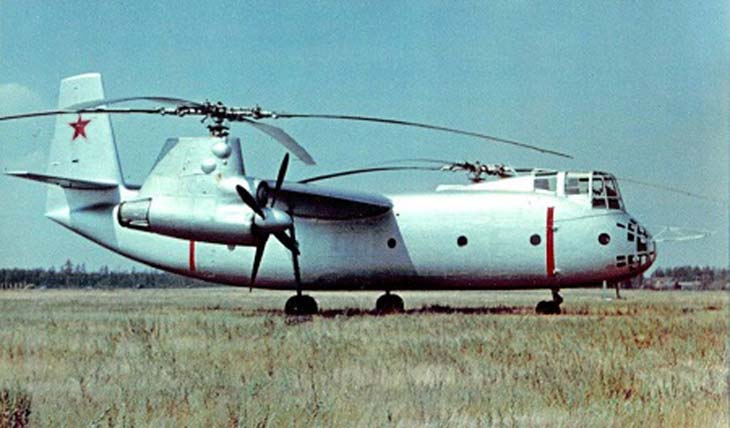Kamov
Ka-22 Vintokryl "Hoop" Helicopter
The Kamov Ka-22, which went by the Nato reporting name "Hoop",
was an experimental heavy-lift helicopter developed by the Soviet
union in the 50's and '60s. The aircraft's nickname was the Vintokryl,
or "screw wing". It was designed to offer the same vertical
take-off and landing capabilitiesas a helicopter combined with the
superior speed and range of a fixed-wing aircraft.
The Kamov Ka-22 helicopter was designed by Valdimir Barshevsky. He
drew up plans in the early 1950s for an unusual helicopter/airplane
combination, and by 1954 the Soviet military requested three prototypes
of the kA-22. Unfortunatelydue to lengthy delays in the project, by
1956 the request had been reduced to just a single aircraft, and this
didn't take to the air until 1959.
During the first test flights it became obvious the aircraft suffered
from serious control issues, leading to yet another delay in production.
However by 1960, the military agreed to a further three prototypes.

The Kamov kA-22was powered by two Soloviev D-25K engines housed
in nacelles at each wingtip. These powered both the large propellers
above, and the smaller tractor propellers used for horizontal flight.
In helicopter mode the propeller drive was disconnected and the flaps
were lowered to 90 degrees. In fixed-wing mode, the lifting rotors
were free to windmill, and the aircraft was controlled by the ailerons
and tail surfaces.
Due to its unique abilities, the kA-22 was able to set 8 world
records for altitude and speed in its class.
The Kamov kA-22 could carry a large payload within its fuselage,
and loading and unloading was facilitated by the large front door
which hinged from the right hand side and consisted of the entire
nose of the aircraft - excluding the cockpit above. It could carry
100 passengers, and the maximum load carried by the helicopter
in testing was 32,000 lbs (16,485 kgs). It had a top speed of 233
mph.
Sadly, of the four aircraft built, two were destroyed in fatal
crashes. The first occurredin 1962, when kA-2201-01 crashed en-route
to Moscow for testing. The entire crew were killed after the aircraft
rolled to the left and hit the ground inverted. The cause of the crash
was found to be the pitch control linkage on the starboard rotor.
Inspection of the other prototypes showed that two of the other three
aircraft suffered from similar problems. A complex autopilot system
was subsequently fitted which fed into the control system based on
input from sensors monitoring the attitude and angular acceleration
of the aircraft.
The second crash happened almost exactly two years later in August
1964, when Ka-22 01-03 was destroyed after the aircraft entered an
uncommanded right turn which developed into a steep dive. The call
was given to bail out, and three of the crew survived. However the
pilot, Col S.G. Brovtsev, and technician A.F. Rogov were killed in
the crash.
After this second incident, the Kamov kA-22project was canceled.The
Soviet military had already chosen the more conventional Mil Mi-6
as their heavy-lift helicopter. The remaining two prototypes, 01-02
and 01-04 were both scrapped. |

